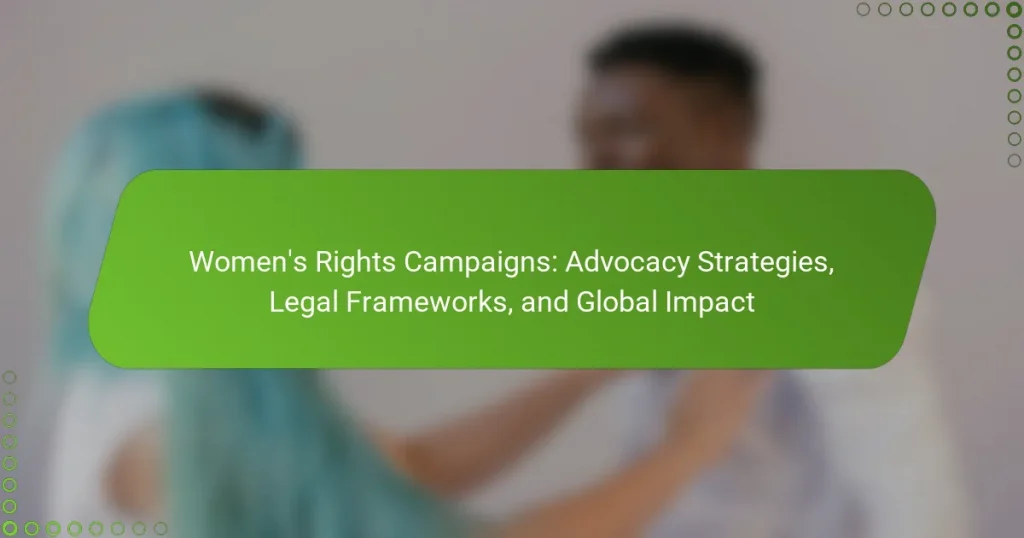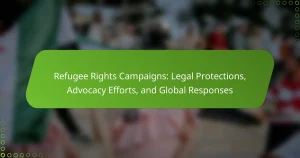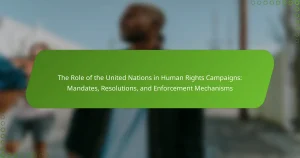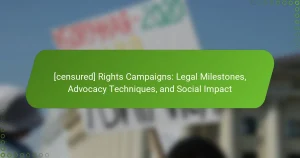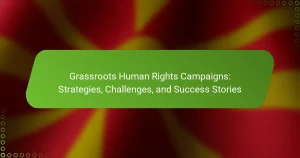Women’s rights campaigns are organized efforts aimed at advocating for gender equality and protecting women’s rights, focusing on issues such as reproductive rights, gender-based violence, and workplace equality. These campaigns utilize advocacy strategies like grassroots mobilization, policy advocacy, and public awareness initiatives to create systemic change. Historical movements, such as the suffrage movement, have significantly influenced legal reforms and increased awareness about women’s issues globally. Research indicates that countries with active women’s rights campaigns experience improvements in gender parity, showcasing the campaigns’ critical role in advancing social justice and equity.
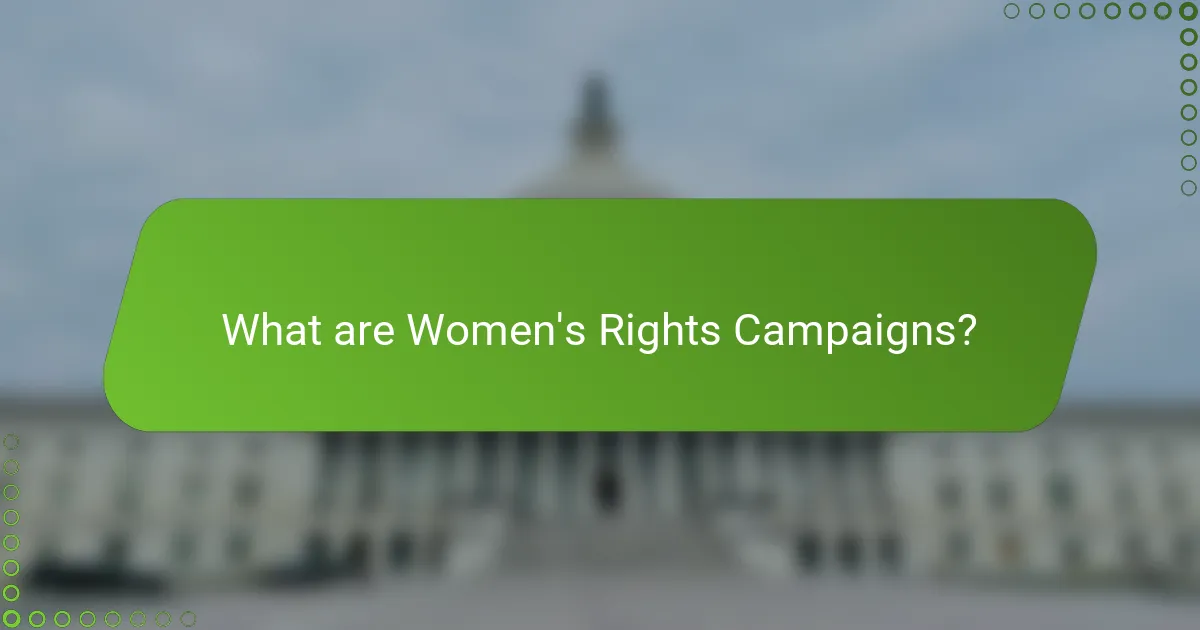
What are Women’s Rights Campaigns?
Women’s rights campaigns are organized efforts aimed at advocating for gender equality and the protection of women’s rights. These campaigns address issues such as reproductive rights, gender-based violence, and workplace equality. They often involve grassroots activism, legal challenges, and public awareness initiatives. Historical examples include the suffrage movement, which fought for women’s voting rights. Statistics show that countries with active women’s rights campaigns see improvements in gender parity. For instance, the UN reports that increased advocacy has led to policy changes in many nations. Women’s rights campaigns are crucial for advancing social justice and equity.
How have Women’s Rights Campaigns evolved over time?
Women’s rights campaigns have evolved significantly over time. Initially, the focus was on suffrage in the late 19th and early 20th centuries. Women fought for the right to vote, leading to milestones like the 19th Amendment in the U.S. in 1920. In the mid-20th century, campaigns expanded to address workplace rights and reproductive rights. The feminist movements of the 1960s and 1970s emphasized gender equality and anti-discrimination laws. In recent decades, campaigns have increasingly highlighted intersectionality, addressing the unique challenges faced by women of color and marginalized groups. Global movements, such as #MeToo, have gained traction, illustrating the ongoing struggle against [censured] harassment and violence. These campaigns have adapted to cultural and technological changes, utilizing social media for outreach and mobilization. Overall, women’s rights campaigns have transitioned from seeking basic legal rights to advocating for comprehensive social justice.
What historical milestones have shaped Women’s Rights Campaigns?
The historical milestones that have shaped Women’s Rights Campaigns include the Seneca Falls Convention in 1848, which marked the first organized movement for women’s rights in the United States. The passage of the 19th Amendment in 1920 granted women the right to vote in the U.S. This was a significant victory for the suffrage movement. The Equal Pay Act of 1963 aimed to abolish wage disparity based on [censured]. The Women’s Liberation Movement of the 1960s and 1970s brought attention to issues such as reproductive rights and workplace equality. Internationally, the adoption of the Convention on the Elimination of All Forms of Discrimination Against Women (CEDAW) in 1979 established a framework for women’s rights globally. The #MeToo movement, which gained prominence in 2017, highlighted [censured] harassment and assault, further energizing women’s rights advocacy. Each of these milestones contributed to the ongoing struggle for gender equality and shaped the landscape of women’s rights campaigns.
How do cultural contexts influence Women’s Rights Campaigns?
Cultural contexts significantly influence women’s rights campaigns by shaping societal norms and values. These contexts determine the priorities and strategies of advocacy groups. For instance, in some cultures, issues like education and healthcare access are prioritized, while in others, legal rights may take precedence. Cultural beliefs can also affect the reception of campaigns, influencing public support or opposition. For example, campaigns in conservative societies may face resistance due to traditional gender roles. Furthermore, local customs and practices can dictate the methods of advocacy used. In regions where women have limited public visibility, grassroots movements may be more effective. Historical context also plays a role; countries with a history of colonialism may approach women’s rights differently than those without such a legacy. Overall, understanding cultural contexts is essential for tailoring effective women’s rights campaigns.
What are the key objectives of Women’s Rights Campaigns?
The key objectives of Women’s Rights Campaigns include promoting gender equality, advocating for legal reforms, and raising awareness about women’s issues. These campaigns aim to eliminate discrimination and violence against women. They seek to ensure equal access to education and healthcare for all women. Women’s rights campaigns also focus on empowering women economically and politically. They strive to increase women’s representation in leadership roles. Additionally, these campaigns work to challenge societal norms that perpetuate gender inequality. Evidence shows that countries with active women’s rights movements report improved gender parity in various sectors.
What specific issues do Women’s Rights Campaigns address?
Women’s Rights Campaigns address issues such as gender equality, reproductive rights, and violence against women. They advocate for equal pay and workplace rights. Campaigns also focus on women’s health and education access. Legal reforms for domestic violence and [censured] harassment are critical areas of advocacy. Additionally, these campaigns aim to combat human trafficking and child marriage. They promote women’s political representation and participation in decision-making. Statistics show that women globally earn 23% less than men, highlighting the pay gap issue. Furthermore, one in three women experience physical or [censured] violence in their lifetime, underscoring the need for action against violence.
How do these objectives vary across different regions?
Objectives of women’s rights campaigns vary significantly across different regions. In developed regions, objectives often focus on gender equality in the workplace and reproductive rights. For instance, in Europe, campaigns emphasize equal pay and combating workplace discrimination. In contrast, developing regions prioritize basic rights such as access to education and freedom from violence. For example, in parts of Africa, campaigns may focus on eradicating harmful practices like female genital mutilation. Cultural, social, and economic factors heavily influence these objectives. According to the UN Women report, regional disparities in women’s rights highlight the need for tailored advocacy strategies.
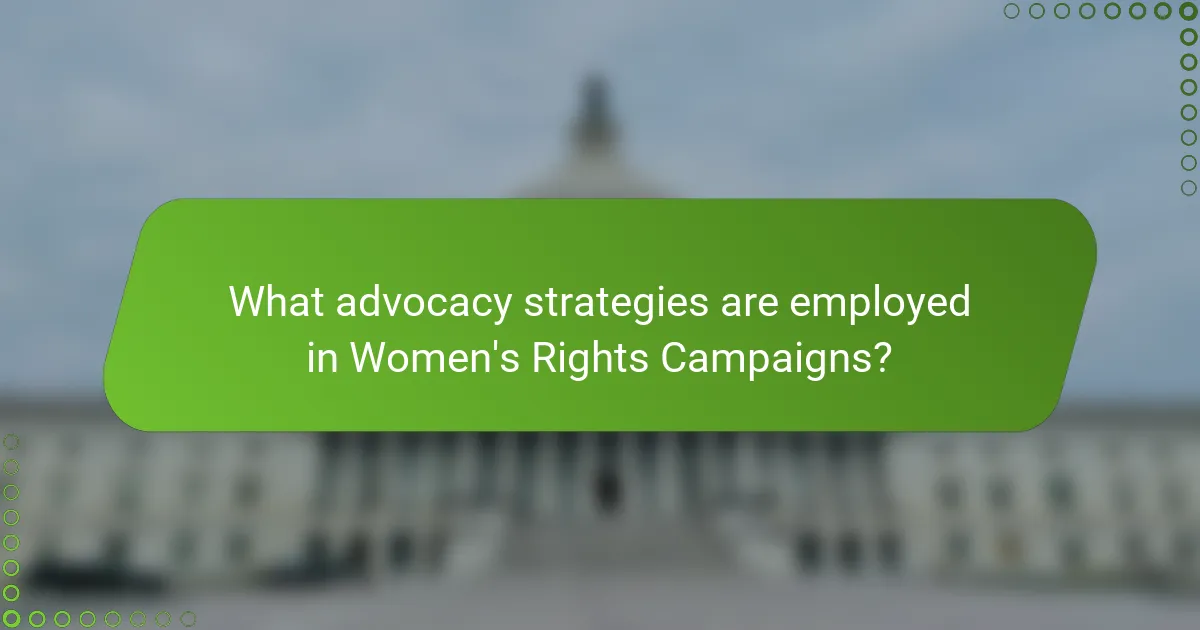
What advocacy strategies are employed in Women’s Rights Campaigns?
Advocacy strategies employed in Women’s Rights Campaigns include grassroots mobilization, policy advocacy, and public awareness campaigns. Grassroots mobilization engages local communities to raise support and participation. This strategy often utilizes social media to amplify voices and organize events. Policy advocacy focuses on influencing legislation and government policy to promote women’s rights. This includes lobbying efforts directed at lawmakers. Public awareness campaigns educate the general public about women’s issues and rights. These campaigns often highlight statistics and personal stories to foster empathy and support. Collaboration with NGOs and international organizations enhances the reach and impact of these strategies. Each strategy is designed to create systemic change and promote gender equality.
How do grassroots movements contribute to Women’s Rights Campaigns?
Grassroots movements significantly contribute to women’s rights campaigns by mobilizing community support and raising awareness. These movements often originate from local communities, addressing specific issues faced by women. They empower individuals by providing education on women’s rights and legal protections. Grassroots organizations frequently engage in advocacy efforts, influencing policy changes at local and national levels. For example, the #MeToo movement galvanized global attention to [censured] harassment and assault, leading to legislative reforms in various countries. Additionally, grassroots movements create networks for women to share experiences and strategies, fostering solidarity. Research shows that grassroots activism can increase public engagement and pressure on policymakers, enhancing the effectiveness of women’s rights campaigns.
What role does community organizing play in these movements?
Community organizing plays a crucial role in women’s rights movements. It mobilizes individuals to advocate for social change. Organizing fosters collective action, empowering women to voice their needs. Through grassroots efforts, communities can challenge systemic inequalities. Research shows that organized groups achieve greater policy influence. For instance, the Women’s March in 2017 united millions globally for gender equality. This demonstrates the effectiveness of community organizing in amplifying women’s issues. Overall, it strengthens solidarity and drives impactful advocacy.
How do social media campaigns enhance visibility and engagement?
Social media campaigns enhance visibility and engagement by leveraging platforms to reach wide audiences. They allow organizations to share messages quickly and effectively. Content can be tailored to target specific demographics. Visual elements like images and videos increase user interaction. Hashtags and trends help amplify messages beyond immediate followers. Engagement metrics, such as likes and shares, provide feedback on campaign effectiveness. Studies show that campaigns on platforms like Twitter and Instagram can increase awareness significantly. For example, a campaign may lead to a 50% increase in online discussions about women’s rights issues.
What legal frameworks support Women’s Rights Campaigns?
Legal frameworks that support women’s rights campaigns include international treaties, national laws, and regional agreements. The Convention on the Elimination of All Forms of Discrimination Against Women (CEDAW) is a key international treaty. It mandates countries to eliminate discrimination against women and promote gender equality. National laws, such as the Equal Pay Act and Violence Against Women Act in the United States, provide legal protections for women’s rights. Regional frameworks, like the African Charter on Human and Peoples’ Rights, also address women’s rights. These legal instruments create obligations for governments to protect and promote women’s rights. They provide mechanisms for accountability and support advocacy efforts.
What international treaties and agreements promote women’s rights?
International treaties and agreements that promote women’s rights include the Convention on the Elimination of All Forms of Discrimination Against Women (CEDAW). CEDAW was adopted by the United Nations in 1979 and serves as a key international bill of rights for women. It outlines various forms of discrimination against women and mandates states to take appropriate measures to eliminate such discrimination.
Another significant agreement is the Beijing Declaration and Platform for Action, established in 1995 during the Fourth World Conference on Women. This document sets strategic objectives and actions to achieve gender equality and empower women globally.
Additionally, the United Nations Sustainable Development Goals (SDGs), particularly Goal 5, aim to achieve gender equality and empower all women and girls by 2030. These agreements collectively provide a framework for promoting women’s rights and addressing gender-based discrimination worldwide.
How do national laws impact the effectiveness of Women’s Rights Campaigns?
National laws significantly influence the effectiveness of Women’s Rights Campaigns. Laws that promote gender equality can empower campaigns by providing a supportive legal framework. For instance, countries with laws against gender-based violence often see more active advocacy efforts. Conversely, restrictive laws can hinder campaigns by limiting freedom of expression and assembly. In places where women’s rights are not legally recognized, campaigns struggle to gain traction. Furthermore, the enforcement of existing laws is crucial; weak enforcement can undermine the intent of legal protections. Research shows that nations with robust legal frameworks experience higher rates of gender equality advancements. Thus, the nature and enforcement of national laws are critical factors in the success of Women’s Rights Campaigns.
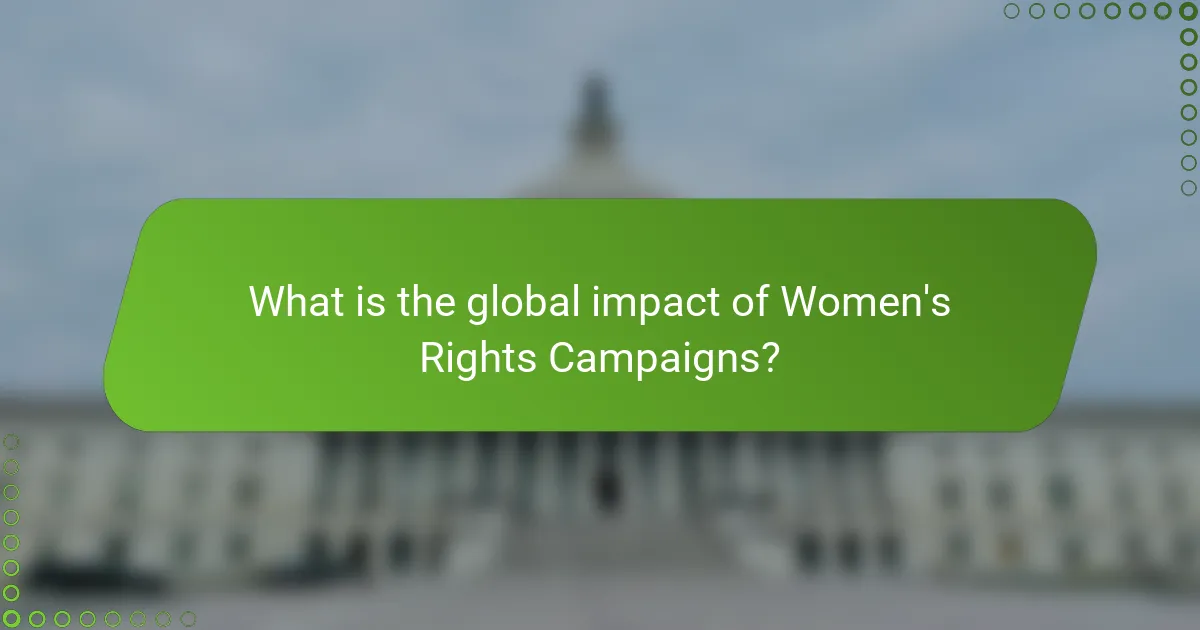
What is the global impact of Women’s Rights Campaigns?
Women’s rights campaigns have significantly influenced global gender equality. These campaigns have led to legal reforms in many countries. For example, the campaign for women’s suffrage resulted in women gaining the right to vote in numerous nations. Women’s rights movements have raised awareness about issues such as domestic violence and workplace discrimination. According to the World Economic Forum, gender parity in various sectors has improved due to these efforts. Campaigns also promote women’s participation in politics and leadership roles. The United Nations has recognized women’s rights as human rights, further legitimizing these movements. Overall, women’s rights campaigns have fostered social change and empowered women worldwide.
How do Women’s Rights Campaigns influence policy changes worldwide?
Women’s rights campaigns significantly influence policy changes worldwide by raising awareness and mobilizing public support. These campaigns often highlight issues such as gender equality, reproductive rights, and violence against women. They utilize various strategies, including grassroots organizing, social media advocacy, and legal challenges.
For example, the #MeToo movement led to legislative changes in several countries regarding [censured] harassment laws. Research shows that countries with active women’s rights movements have more progressive policies on gender issues. According to a study by the World Bank, increased women’s participation in advocacy correlates with improved legal frameworks for women’s rights.
These campaigns also engage policymakers directly, pushing for reforms through lobbying efforts. The United Nations recognizes the role of women’s rights movements in shaping international agreements, such as the Convention on the Elimination of All Forms of Discrimination Against Women (CEDAW). Overall, women’s rights campaigns are crucial in driving legislative and societal changes that promote gender equality globally.
What examples illustrate successful policy reforms driven by these campaigns?
The successful policy reforms driven by women’s rights campaigns include the passage of the Violence Against Women Act (VAWA) in the United States. This law was enacted in 1994 to address domestic violence and [censured] assault. It provided federal resources for law enforcement and victim services. Another example is the adoption of the Convention on the Elimination of All Forms of Discrimination Against Women (CEDAW) by many countries. This international treaty aims to eliminate gender discrimination in various areas. In 2010, Spain implemented a comprehensive law on gender-based violence, influenced by advocacy groups. These reforms illustrate the impact of sustained advocacy efforts on policy change.
How do Women’s Rights Campaigns contribute to global gender equality?
Women’s rights campaigns advance global gender equality by advocating for legal reforms and social change. These campaigns highlight systemic injustices faced by women. They raise awareness about issues like violence, discrimination, and economic inequality. Advocacy efforts often lead to policy changes that promote women’s rights. For instance, the #MeToo movement has led to stronger laws against [censured] harassment in many countries. Women’s rights campaigns also empower women through education and resources. They provide platforms for women to voice their experiences and demands. Statistical evidence shows that countries with active women’s rights movements have higher gender equality indices.
What challenges do Women’s Rights Campaigns face today?
Women’s rights campaigns face significant challenges today. These include legal barriers, societal resistance, and funding shortages. Legal barriers often stem from outdated laws that do not protect women’s rights adequately. Societal resistance manifests in cultural norms that prioritize traditional gender roles. Funding shortages hinder the ability of organizations to reach broader audiences and implement effective programs. Additionally, misinformation and backlash against feminism can undermine campaigns. According to the United Nations, 1 in 3 women globally experience violence, highlighting the urgent need for effective advocacy. These challenges complicate the pursuit of gender equality and women’s empowerment.
How do political and social obstacles hinder progress?
Political and social obstacles hinder progress by creating barriers to women’s rights initiatives. These obstacles can include restrictive laws and policies that limit women’s participation in decision-making. Additionally, societal norms may perpetuate gender discrimination and hinder advocacy efforts. For example, in many countries, cultural beliefs prioritize traditional gender roles, which can obstruct women’s empowerment. Research indicates that political instability can also divert attention and resources away from women’s rights issues. According to the World Economic Forum, countries with higher gender equality experience faster economic growth. Therefore, addressing these political and social challenges is crucial for advancing women’s rights and achieving broader societal progress.
What strategies can campaigns adopt to overcome these challenges?
Campaigns can adopt several strategies to overcome challenges in women’s rights advocacy. First, building coalitions with local organizations enhances outreach and resource sharing. Collaborative efforts amplify voices and increase visibility. Second, utilizing social media platforms effectively can engage a broader audience. Campaigns can share stories and mobilize supporters quickly. Third, focusing on education and awareness is crucial. Informing communities about women’s rights fosters understanding and support. Fourth, leveraging data and research can strengthen arguments. Concrete statistics on gender inequality provide a solid foundation for advocacy. Fifth, engaging policymakers through direct lobbying can influence legislative change. Presenting clear demands and evidence can lead to policy reforms. Lastly, employing grassroots organizing empowers communities. Mobilizing local support creates a sustainable movement for change. These strategies collectively enhance the effectiveness of women’s rights campaigns in addressing challenges.
What best practices can enhance the effectiveness of Women’s Rights Campaigns?
Effective women’s rights campaigns can be enhanced by employing targeted messaging, community engagement, and coalition-building. Targeted messaging ensures that the campaign resonates with specific audiences. Research shows that campaigns with clear, relatable messages see higher engagement rates. Community engagement fosters grassroots support and empowers local voices. Studies indicate that campaigns involving community participation are more successful in achieving their goals. Coalition-building unites various organizations and stakeholders, amplifying the campaign’s reach and impact. Successful campaigns often leverage partnerships to strengthen their advocacy efforts. Utilizing digital platforms enhances visibility and allows for broader outreach. Data from recent campaigns suggest that those using social media effectively can mobilize larger audiences.
How can collaboration among organizations improve outcomes?
Collaboration among organizations can improve outcomes by leveraging diverse expertise and resources. When organizations work together, they can share knowledge and best practices. This leads to more effective strategies and innovative solutions. Collaborative efforts can also amplify advocacy messages, increasing visibility and impact. Research shows that partnerships can enhance funding opportunities and resource allocation. For instance, a study by the United Nations Development Programme found that collaborative projects in women’s rights initiatives resulted in 30% more effective outcomes. Collaborative networks foster a sense of community and shared purpose. This unity can drive collective action and influence policy changes more effectively.
What role does public awareness play in strengthening campaigns?
Public awareness plays a crucial role in strengthening campaigns. It enhances visibility and understanding of women’s rights issues. Increased awareness mobilizes community support and encourages participation. Informed individuals are more likely to advocate for change. Campaigns with high public awareness often achieve greater media coverage. This media attention can influence policymakers and drive legislative action. Research shows that campaigns with strong public engagement see a 30% increase in support for policy changes. Therefore, public awareness is essential for the success of women’s rights campaigns.
Women’s rights campaigns are organized efforts advocating for gender equality and the protection of women’s rights, addressing issues such as reproductive rights, gender-based violence, and workplace equality. The article explores the evolution of these campaigns, key historical milestones, cultural influences, and their objectives across different regions. It also examines advocacy strategies, the role of grassroots movements, legal frameworks, and the global impact of these campaigns on policy changes and gender equality. Additionally, the article discusses the challenges faced by women’s rights campaigns today and best practices for enhancing their effectiveness.
